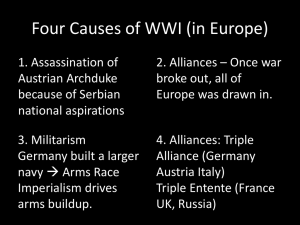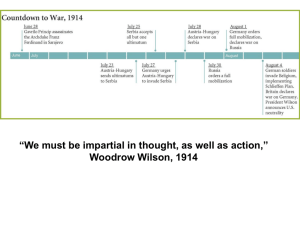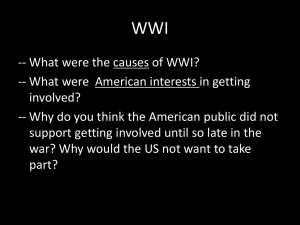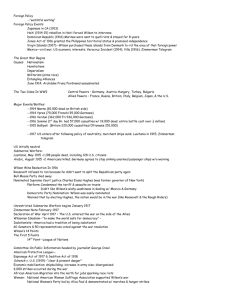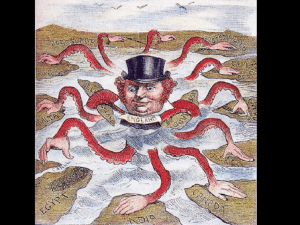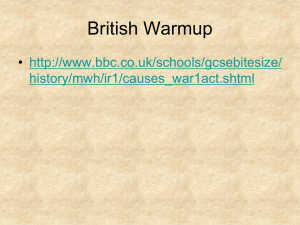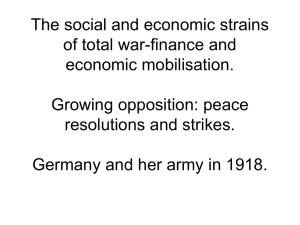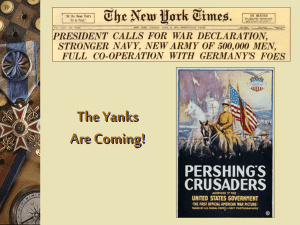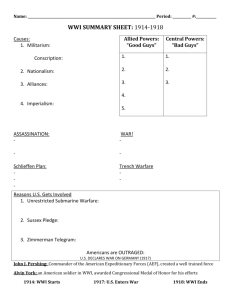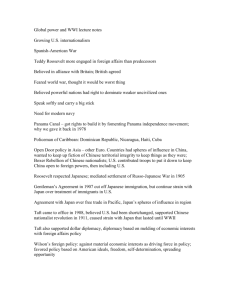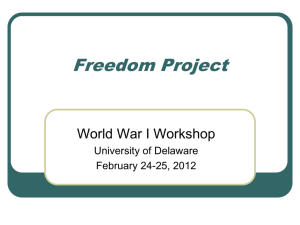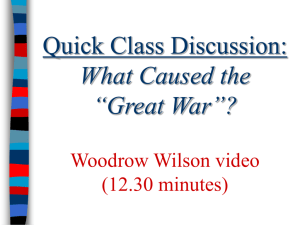Duchamp's
advertisement
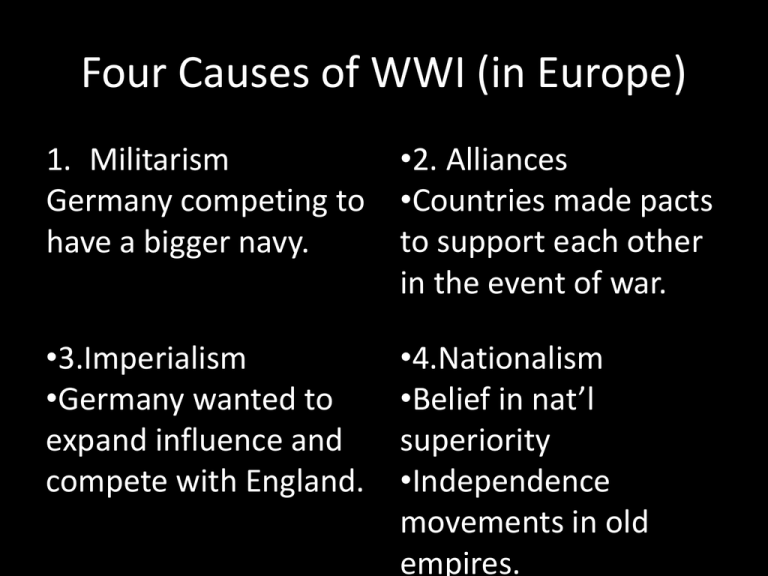
Four Causes of WWI (in Europe) 1. Militarism Germany competing to have a bigger navy. •2. Alliances •Countries made pacts to support each other in the event of war. •3.Imperialism •Germany wanted to expand influence and compete with England. •4.Nationalism •Belief in nat’l superiority •Independence movements in old empires. In 1914, the British Empire covered about ¼ of the world’s land and ruled over about 1/5 of it’s population. US policy of neutrality. In what ways was the US not particularly neutral before entering the war? Wilson wanted friendly foreign relations. US wanted to sell materiel and keep peace with both sides; US was funding both sides of the war. Isolationism: US did not want to get drawn into foreign conflict US had nothing to gain Keep America Safe! High cost of war. Lusitania and Submarine Warfare •Lusitania 1915 •British Passenger ship sunk, killing civilians. •US threatened Germany if they did not end unrestricted Submarine Warfare. •Held weapons shipments. •Unrestricted Submarine Warfare •If UK can be cut off by sea, they would starve and exit war. •Germany pledged to stop indiscriminate sinking of civilian ships. Zimmermann Telegram Decoded in January, 1917: Shared with US at end of February. England waited to share intelligence to make US more likely to join war; to hide UK spying capability from Germans. Germany proposed plan to get Mexico to enter war against US Wilson showed Congress US declares war in April. Mexico might want to join war: Pancho Villa and Vera Cruz. Woodrow Wilson •Insists on “open door” to make the world safe for democracy. •1918 – endorses women’s suffrage as vital for winning the war. (by 1917, 16 states had given women the right to vote). •Obsessive fear of disloyalty: –Espionage Act (900 people sentenced to prison during war) –Sedition Act –Selective Service Act –Trading with the Enemy Act –Alien Enemies Act –Alien Act US Cavalry invading Mexico in pursuit of Pancho Villa in 1916. Trade and Economics Making the World Safe for Democracy •US spent $32 billion (52% of GNP). •Money raised for war with taxes and War Bonds (like savings bonds), and sales of public land. •US trading with both sides of war; UK blockaded US ships from going to Germany. US could not access German markets traded with UK instead. •US loaned $2bil to UK by 1917 (if UK lost war, US would not get $back) Trade and Economics •In 1917, the estimated cost of the war was $3.5 billion. –Actual cost: $35 billion & 116,516 US soldiers. •The US had loaned $2 billion to Britain and France before entering the war, compared to $27million to Germany. Tax Base •Before the war, most of the government’s revenue came from tariffs. •In 1917, the War Revenue Act was passed, imposing an “excess profits levy” as high as 60%. –Fed. Revenue went from $930 million in 1916 to $4,388 million in 1918 •The personal exemption for income tax went from 3,000 – 1,000 •Tax on earnings above $500,000 went from 7% to 77% –Thus the income tax became the most important source of federal revenues. 4. Demographics • Fertility rates (# of kids born): drastically dropped during war “Baby Boom” • Portion of men dropped, making recovery slower. Demographics •1/3 of Americans were 1st or 2nd generation Germans. –These 8 million Germans and another 4 million Irish did not love England. •National Defense Act of 1916 expanded Army from 90,000 to 175,000 –While Wilson was still maintaining a policy of neutrality, a draft was instituted to expand the army. African Americans in WWI • Four all-black regiments in the army. • Very few African Americans saw combat: most were labor batallions. • All-Black regiments not sent overseas. • Unequal treatment from other parts of army. • First Africans sent overseas as part of service unit. US Army •1917: US Army was the 7th largest in the world. Equipped with old weapons and only had a day and a half of ammunition in reserve. –Spring, 1917: Army + Nat’l Guard =379,000 –End of War: 3.7 million •Early summer, 1917: token American forces and the French Army was plagued by mutinies. •March, 1918: 300,000 Americans in France •November, 1918: over 2 million! •(1,400,000 of them saw action) •367,000 African American troops WWI and Women •- Free Speech in times of war WWI Ends the Progressive Era - World War and the death of Progressive Party •By 1916, Progressives became extremely committed to the defense of national honor, nationalism, and opposition to Wilson. But, imperialism and militarism replaced old liberal formulas of protest, and within a year, the party was dead. •War was justified with progressive rhetoric and on progressive terms. –Discredited progressive language – morals and ideals –Guaranteed that anti-war reactions would be antiprogressive. US Reaction to the Russian Revolution of 1917 •- Human cost of WWI •10 million military and 7 million civilians were killed in the war. (~ 117,000 Americans). •20 million died of hunger and disease related to war. –Spanish Flu killed 600,000 Americans in 1918 and 1919. National War Labor Board NWLB •To mediate disputes, recognize fair wages and hours, collective bargaining. •War Labor Policies Board –Set standards for federal employees Neutrality? •William Jennings Bryan: Wilson practiced a false neutrality by allowing US passengers on ships that we know might be sunk. The ships are not neutral. 5. Wilson, WWI and Progressivism Civil Society on the eve of war 1913 Armory Show, Chicago $45,000 worth of paintings sold! Duchamp’s Nude descending a Staircase (or, explosion in a shingle factory) Wassily Kadinsky – Improvisation #27 – Garden of Love Matisse’s work was chosen by students at Chicago's Art Student's League as the most appalling and blasphemous pictures in the exhibition. The charges brought against him were "artistic murder, pictorial arson, artistic rapine, total degeneracy of color, criminal misuse of line, general aesthetic abberation, and contumacious abuse of title“ Troubled by the public’s reaction to his work, Matisse said in an interview: "Oh do tell the American people that I am a normal man; that I am a devoted husband and father, that I have three fine children, that I go to the theatre!" Meanwhile, in Europe, the press had been paying attention to the Caillaux affair. Joseph Caillaux, former premier and current minister of finance and radical socialist leader in France was accused of high crimes and misdemeanors. His wife was enraged by how the press had destroyed his career. She decided to solve the problem by buying a gun and killing the responsible journalist. When news arrived of the assassination of the Archduke Franz Ferdinand in Serbia, it seemed only a brief distraction from the Calliaux trial. How did the war affect the Economy? •-- Unions •-- Wages •-- Production •-- Taxes How do you think the war affected politics? WWI killed 10 million in battle 2 million died of hunger related to war Efforts to save grain led to the 19th Amendment– prohibition. 1915-1918: the real income of farmers grew 30% $20 billion were raised with Liberty Bonds Bernard Baruch, head of the War Industries Board (WIB) Women working in a shipyard, 1918 1918, the government wanted to encourage women to work on farms to keep food production up. Women in the Workforce Wartime policies and economic changes wound up killing progressivism, even though progressives were in power. Why do you think? Red Scare •Russian Revolution causes fear of communism in America. •US passes laws to crack down against socialists. Peace Conference at Versailles •One reason Wilson wanted to join the war, was to participate in the peace conference. –14 Points: US goals in peace •Free Trade in Europe •Self Determination (Countries can choose their own form of Gov’t, but not for colonies) •League of Nations –Republicans feared that it would force the US into another foreign war. –US never joined.
